|
Twenty-six species of fish are present within the waters of Pipestone Creek. Pipestone Creek provides habitat for the federally endangered Topeka Shiner, a minnow averaging 2-3 inches in length. Due to the rare nature of the Topeka shiner, monitoring is conducted annually to assess the health of the Pipestone Creek population. (For more information, check out the articles at the bottom of the page.) 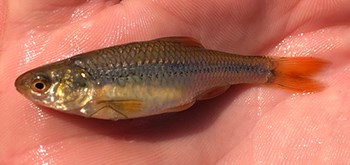
Seth Hendriks/NPS Common names: Topeka Shiner, Common Shiner, Bigmouth Shiner, Red Shiner, Sand Shiner, Central Stoneroller, Common Carp, Brassy Minnow, Bluntnose Minnow, Fathead Minnow, Southern Redbelly Dace, Blacknose Dace, Creek Chub Appearance: Although most are small (less than 12"), these fish do vary greatly in size, so that's not a reliable indicator. However, there are some shared characteristics: minnows have one dorsal fin along with an anal fin which is located farther forward than on similar fish such as suckers. Minnows also don't have teeth in their jaw, but have teeth-like structures on their pharyngeal bone (which supports gill tissues) which they use to grind their food against a pad. Are all small fish minnows? No, just because a fish is small doesn't make it a minnow, and not all minnows are small either. In the U.S., the pikeminnow has been known to reach up to 24" in length and weigh over 13 lbs. while the giant barb of Asia easily surpasses 100 lbs. However, you're not likely to find fish quite that big in Pipestone Creek! Why are they important? This group is the largest family of freshwater fish with over 1,000 diverse species. They serve as an important food base for many predators around the world - including humans. 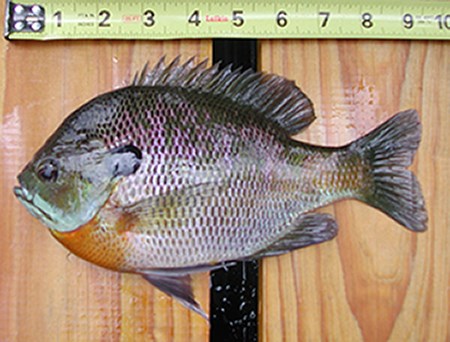
Brian Dykes/Public Domain Common names: Green Sunfish, Orangespotted Sunfish, Bluegill, Black Crappie Appearance: Members of this family usually have a compressed, pancake-like appearance. Their fins have soft rays between stiff spines, with the dorsal fin sporting as many as a dozen stiff spines. Size can vary greatly among the dozens of sunfish species around the country, from 3" to 2' long. Is it true they build underwater nests? Yes! Sunfish are nest builders. Males will build a saucer-shaped nest to attract females and eventually protect as many as 80,000 eggs until they hatch. Why are they important? Sunfishes are carnivorous and help control the insect and crustacean populations. 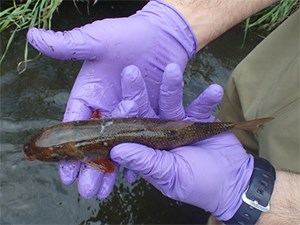
Seth Hendriks/NPS Common names: River Carpsucker, White Sucker Appearance: The river carpsucker has a stout body and arched back with an elongated dorsal fin. It has 18 caudal fin rays and a nipple-like projection in the center of the lower lip. The white sucker has a long cylindrical body shape. Its lower lip is split into two parts and is wider than it is high. White suckers are one of the most common fish species found throughout Minnesota. Why are they important? They do eat small insects and their presence means food for larger fish! However, if not caught or eaten, they can live for 10-12 years. 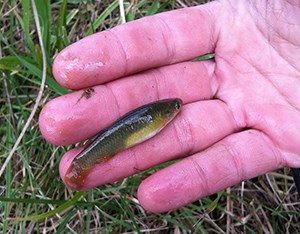
Public Domain/US Fish & Wildlife Service Common name: Plains Topminnow Appearance: They can grow up to 3" long and are olive-green with blue-green cross hatching along their sides. They have a broad, flat head with a protruding lower jaw. The tail fin is rounded and the dorsal fin is located directly overtop the anal fin. The key feature is the gold stripe along its back. Why are they important? These little fish are an 'indicator species.' Their numbers indicate to researchers the state of the environment they're found in as well as the impact of invasive species to the region. These indicator species reveal the impacts of environmental changes quicker than others and thus can serve as a warning for the rest of us. 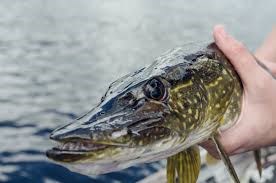
Public Domain/pxhere.com Common name: Northern Pike Appearance: Approximately 18-20" long with light spots along their dark body and green or olive-green sides. They have a single dorsal fin and scales on their cheeks and upper half of their gill covers. Are they carnivorous? You bet! The northern pike is a top predator and will spring at prey from a cocked "s" position, going for anything from other fish to small mammals and birds. If either food or space starts to run low, these fish will even resort to hunting their own. Just how fast are they? These fish can reach speeds of 8-10 mph! Why are they important? They help control the populations of any body of water they're located in, and can be devastating to non-native areas they're introduced to. They also serve as a food source for humans - since these aquatic predators will strike at pretty much anything that moves, they're a favorite among many anglers. 
Public Domain/Image by Ellen Edmonson and Hugh Chrisp as part of the 1927-1940 New York Biological Survey Common name: Brook Stickleback Appearance: This unique looking fish is 1.5-2.5" long with mottled olive-green coloring and 4-6 completely separated dorsal spines. Tough little guys! Males will build nests out of vegetation and engage in courtship dances in order to attract females, and they aggressively protect the eggs one they've been fertilized. These little guys have been known to bite chunks out of the fins of much larger fish while protecting the vulnerable offspring in their nest. Why are they important? Little fish like this are often good for keeping the insect population under control while also serving as a source of food for larger fish in the local area. 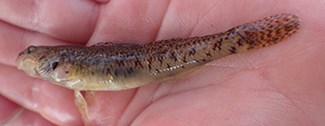
Seth Hendriks/NPS Common name: Johnny Darter Appearance: Approximately 1.5-2.5" long and yellowish-brown in color with black "x" or "w" patterns running along their sides, which can give the appearance of a broken black, lateral stripe. It also sports two dorsal fins, one of which is spinous with the other being soft-rayed. They have rounded tail fins while the pectoral and pelvic fins are relatively close to one another behind the gills. A topsy-turvy technique: The male Johnny darter uses the underside of a rock or a log as a nest, employing his fins to clean out an appropriate space. Both the male and female of this species will swim upside down to deposit the eggs and then fertilize them. The male will then protect the eggs with his life, taking on fish up to 3 times his size! Why are they important? Like many small fish, this species eats insects and in turn serves as food for many other large fish as well as mammals and birds. Additionally, the Johnny darter is a pioneer species, meaning that after extreme disturbances in their habitat, they are among the first to return to it. 
Public Domain/USGS Common names: Black Bullhead, Tadpole Madtom, Stonecat Appearance: This family of bottom-feeders do not have any scales, but do possess several pair of sensory barbels (whiskers) around their mouth that they're known for. Specific descriptions among this family of dozens of species vary, but in general they have a dorsal fin, tail fin, adipose fin (between the dorsal and tail fin), pectoral fins, pelvic fins, and a long anal fin. Tadpole madtom: 2-3" long, dark brown with light stomach, adipose and tail fins merge Stonecat: 6-12" long, yellowish-brown thick skin, rectangular tail fin with no notch Black bullhead: 8-14" long, dark olive to jet black with a notch in the tail fin Look, But Don't Touch! The dorsal and pectoral fins of all catfish are sharp enough to cut, but some can be extremely painful. The stonecat is definitely one to watch out for - they are known for inflicting a nasty sting much like a wasp! Why are they important? They help maintain aquatic ecosystems by scavenging along the bottom of various bodies of water and consuming decayed matter. Catfish in general also serve as an important food source throughout North America. |
Last updated: July 17, 2020
